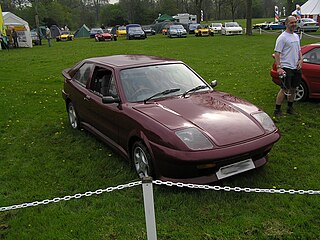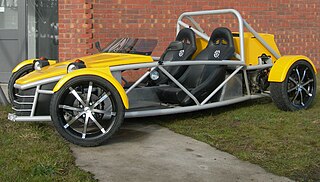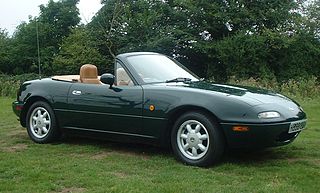
A Locost is a home-built car inspired by the Lotus Seven. The car features a space frame chassis usually welded together from mild steel 1 in × 1 in square tubing. Front suspension is usually double wishbone with coil spring struts. The rear is traditionally live axle, but has many variants including independent rear suspension or De Dion tube. Body panels are usually fiberglass nose and wings and aluminium side panels. Each car is highly individualized according to the resources, needs and desires of each respective builder.

A kit car is an automobile available as a set of parts that a manufacturer sells and the buyer then assembles into a functioning car. Usually, many of the major mechanical systems such as the engine and transmission are sourced from donor vehicles or purchased new from other vendors. Kits vary in completeness, consisting of as little as a book of plans, or as much as a complete set with all components to assemble into a fully operational vehicle such as those from Caterham.
Caterham Cars is a British manufacturer of specialist lightweight sports cars established in Caterham, England, with their headquarters in Dartford, England. Their current model, the Caterham 7, originally launched in 1973, is a direct evolution of the Series 3 Lotus Seven designed by Colin Chapman. In the 1990s the company made the Caterham 21, a two-seater soft top alternative to the MGF and Lotus Elise,. A track-only car, the SP/300.R, a joint project with Lola was released for customer testing in 2010 and was scheduled for release in 2013.
Westfield Sportscars is a manufacturer of both factory built and kit versions of several two-seater, open top sportscars. Their main product is a Lotus Seven inspired car – vehicles originally designed by Colin Chapman with only the bare essentials for motoring in order to give the rawest and most exhilarating driving experience.

Mazdaspeed was Mazda's in-house performance division. The company was a grassroots racing team in Japan. Owned by Mazda Motor Corporation, they built production model vehicles, became involved in motorsports development, and offered performance parts and accessories. Mazda has phased out Mazdaspeed branding and has not offered a Mazdaspeed trim since the 2013 Mazdaspeed3.

Lotus Elan is the name of two separate ranges of automobiles produced by Lotus Cars. The first series of cars was produced between 1962 and 1975 as a rear-wheel drive vehicle. The second series was produced between 1989 and 1995 as a front-wheel drive vehicle.

The Proton Satria is a hatchback automobile produced by Malaysian manufacturer Proton from 1994 to 2005 in the first generation model and from 2006 to 2015 in the Satria Replacement Model (SRM), known as the Proton Satria Neo.

Locust is a kit car inspired by the Lotus Seven. It was first developed in the mid 1980s as a cheap kit car to be built onto the chassis of a Triumph Spitfire, it was later developed into a full kit car which used its own fully designed ladder chassis - unlike others using space frame. The car was famed for its cheap to build construction using MDF in the body, the last kits were produced in early 2000.

The Grinnall Scorpion III, by Grinnall Specialist Cars, is a reverse trike, with two wheels at the front and one at the rear, which is a better-handling configuration than one wheel at the front. Designed in 1991 by Steve Harper, the Scorpion III features a GRP body tub which is bonded to a space frame chassis underneath, and employs a BMW K-series motorcycle engine as its power plant. The engine, gearbox and final drive from the motorcycle are utilised with a special rear wheel which is fitted with a car tyre, as are the front wheels. It has a very good power-to-weight ratio which endows it with excellent performance. The rear wheel is of a smaller circumference than the bike's wheel so the gearing is optimised for a lower top speed of around 125 mph (201 km/h) with 0-60 mph taking around 6 seconds when using a K1100 engine. Any BMW K engine can be used, from a 750 cc 3-cylinder, to a 1200 cc, 4-cylinder, giving power outputs from 75 bhp (56 kW) to 130 bhp (97 kW).
Sylva Autokits is a kit car manufacturer based in Lincolnshire, England. Sylva was founded in 1981 by Jeremy Phillips and has developed and produced a number of small and lightweight sports cars. Sylva cars have won a number of 750 Motor Club Kit Car championships.
Factory Five Racing, Inc. (F.F.R.) is an American automobile company that designs and manufactures assembly kits, chassis, bodies and related components for replicars and sports cars.
750 Motor Club is a motor racing club in the UK. It was founded in 1939 to promote the sporting use of the Austin 7. '750' refers to the near-750cc Austin 7 engine. It later led to racing and the 750 Formula where specials are raced. Famous members include Colin Chapman, Eric Broadley, Adrian Reynard, Arthur Mallock, Derek Bennett, Tony Southgate, Brian Hart, Gordon Murray, Jem Marsh, Frank Costin and Mike Pilbeam. These engineers and designers produced the first Lotus, Lola, Chevron, Speedex, Marcos, Pilbeam and other sports and racing cars between the 1940s and 1960s.

Quantum Sports Cars was founded by Mark and Harvey Wooldridge in 1987.

An exoskeleton car has a visible external frame, being made of steel, aluminum or carbon fiber tubes.

Haynes Roadster is a replica of a Lotus Seven home-built car, according to a book Build Your Own Sports Car: On a Budget by Chris Gibbs (ISBN 1-84425-391-0). A Ford Sierra is used in the car as a donor for drivetrain and suspension components.
The Puma Clubman sports car was conceived and designed by John Karnon and Neville Darwin in Adelaide, Australia based on Ron Champion's book Build your own sports car for as little as £250 - and race it (ISBN 1-85960-636-9). Between 1998 and April 2014, John Karnon constructed 54 chassis and of those 30 have been completed and registered for road use. John Karnon has continued to develop the Puma chassis design to make use of more modern available donor parts.

Alternative Cars Limited is a New Zealand-based kit car company that manufactures fiber-glass bodied cars based on the 1950s MG TF. The company was founded by Russell Hooper, a medical supply representative, as Kit Kars Limited in 1984. In 1996 Kit Kars Ltd changed its name to Alternative Cars Limited. Initially the company operated from the owner's home, until moving to a small 600 square foot workshop in Auckland.
Minari Engineering Ltd. was a Limited company based in Staffordshire, UK. They manufactured two vehicles, the Minari Club Sport, and the Minari Road Sport. They specialised in producing the components required to build cars based upon the Alfa Romeo Alfasud and 33 running gear, with bodies mainly constructed from GRP. These could either be purchased in Kit form or through a build agent, Chameleon Cars. Around 130 Mk2 kits were sold before production finally stopped in 2000.

New Zealand had a long history of small garages and vehicle enthusiasts modifying and creating sports and sports racing cars. Out of these interests grew the New Zealand kit and replica car industry with the introduction of fibre-glass car bodies in the 1950s.

The Mazda MX-5 (NA) is the first generation of the Mazda MX-5 manufactured from 1989 to 1997. Inspired by the post-war era British sports cars, the MX-5 rejuvenated interest in roadsters after the demise of cars such as the MG B and Triumph Spitfire. Since its debut, the MX-5 has won numerous automotive awards and has become the world's best selling sports car.























